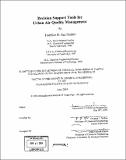Decision support tools for urban air quality management
Author(s)
San Martini, Federico M. (Federico Matteo), 1973-
DownloadFull printable version (14.05Mb)
Other Contributors
Massachusetts Institute of Technology. Dept. of Chemical Engineering.
Advisor
Gregory J. McRae.
Terms of use
Metadata
Show full item recordAbstract
This thesis developed and applied tools to bridge the gap between available data and action for urban air quality management, focusing on strategies to reduce particle concentrations. One of the principal thesis contributions is a Bayesian method to exploit the asymmetry between the rich aerosol dataset and the relatively poor dataset on gas-phase precursors. A Markov Chain Monte Carlo algorithm was combined with the equilibrium inorganic aerosol model ISORROPIA to produce a powerful tool to analyze aerosol data and predict gas phase concentrations where these are unavailable. The method directly incorporates measurement uncertainty, prior knowledge, and provides for a formal framework to combine measurements of different quality. Applying the method to data from Mexico City, evidence for stable and metastable aerosols was found. Gas phase concentrations were estimated including, for the first time in Mexico City, hydrochloric acid. The MIT Inorganic Aerosol Model was developed based on the work of Resch (1995). The equilibrium treatment of ammonia and nitric acid is included in the model, as is the partial dissociation of bisulfate. Model predictions were critically compared with available models and data, and the role of complexes and hydrates investigated. For the first time, a model that includes complexes and hydrates was applied to an urban environment. Based on 1997 data from Mexico City, it was found that complexes and hydrates are predicted to form in a majority of cases. (cont.) Despite their frequent formation, their effect on model predictions is small given the uncertainties in thermodynamic parameters and field observations. Reductions in ammonia concentrations are likely to be less effective at reducing PM2.5 in Mexico City than expected, while reductions in nitrate and sulfate are expected to be effective. This conclusion is robust including or excluding complexes and hydrates and assuming stable or metastable aerosols, although the best model performance is achieved assuming efflorescence. An inverse technique to estimate the emission rate of a point source using field observations was developed. The relatively simple model minimizes data requirements and is broadly applicable. By incorporating the uncertainty in wind direction, the emissions rate of a tracer was recovered within measurement uncertainty.
Description
Thesis (Ph. D.)--Massachusetts Institute of Technology, Dept. of Chemical Engineering, 2004. Includes bibliographical references (p. 269-283).
Date issued
2004Department
Massachusetts Institute of Technology. Department of Chemical EngineeringPublisher
Massachusetts Institute of Technology
Keywords
Chemical Engineering.